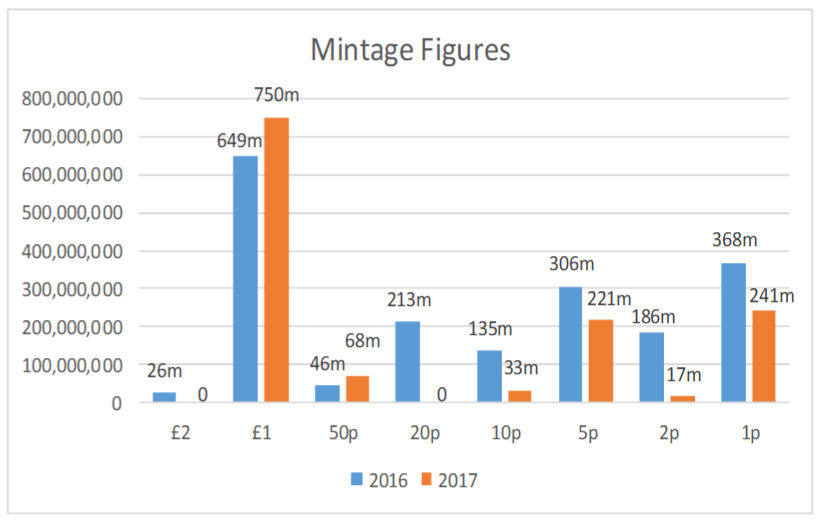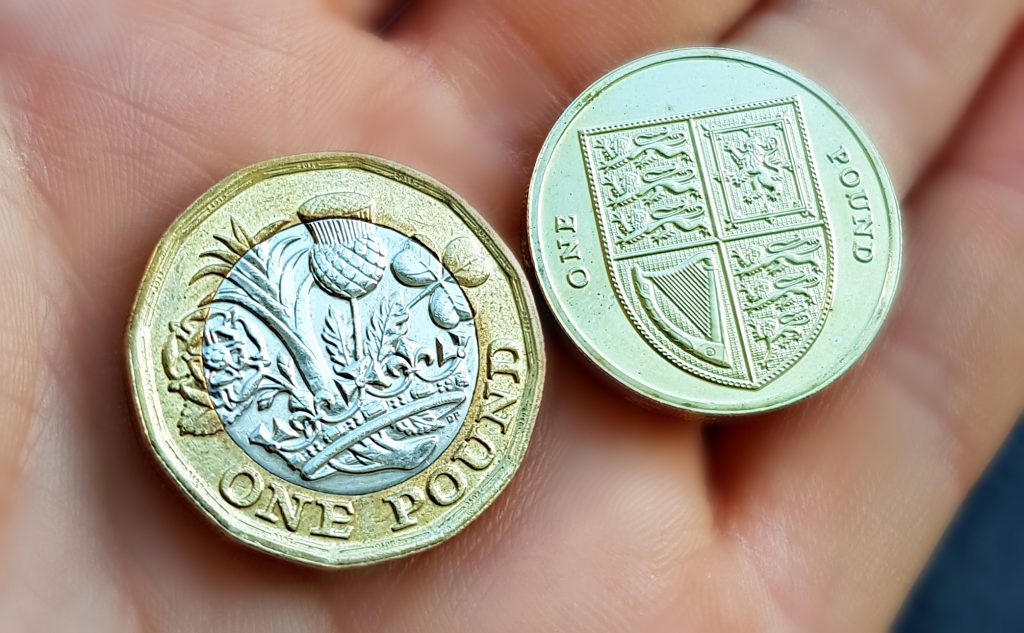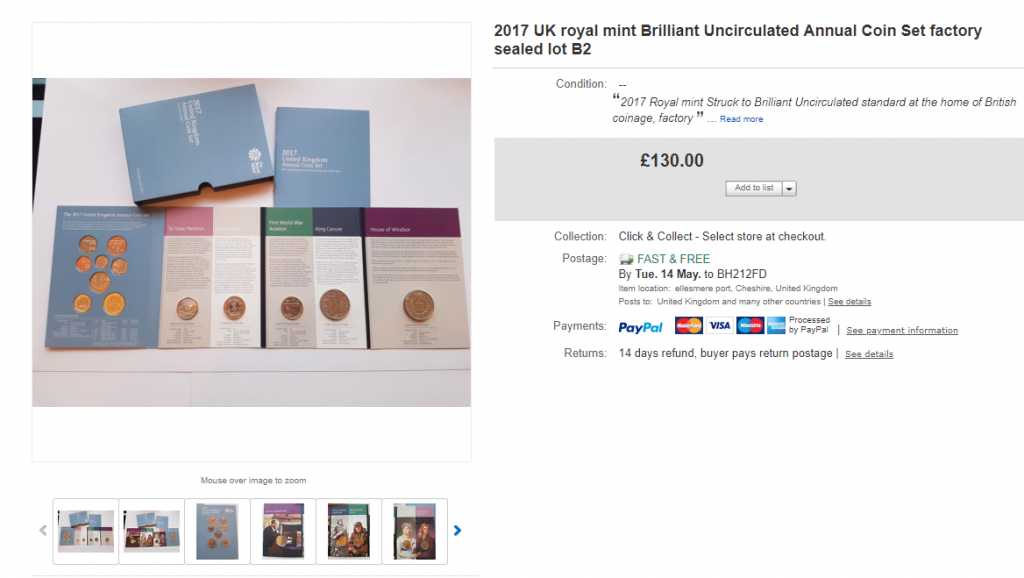Posts by Rachel
Why you won’t find any 2017 20p coins in your change…
For those of you collecting date runs, you might have noticed that in 2017 The Royal Mint didn’t strike a single £2 or 20p coin for general circulation.
In 2016, nearly 29 million £2 coins and almost 213 million 20p coins were struck for circulation, however the next year that number dropped to 0.

From the graph above, you’ll notice that whilst most denominations had relatively few coins struck in 2017 compared to 2016, the mintage figure for £1 coins for both years is comparatively very high.
Introduction of the new £1
It’s thought that the introduction of the new 12 sided £1 coin to replace the old round pound in 2017 affected the demand for the other coins in circulation.

This could be down to the fact that the public were emptying their piggy banks and checking their loose change to make sure their old pound coins were used up before shops stopped accepting them. In doing so, they also ended up spending other coins in their change, meaning there was plenty of cash to re-circulate, and not as much demand for new coins to be struck for circulation.
This coupled with the growth of card payments and the decline of cash transactions, as well as the impressive 25-30 year lifespan of UK coins meant that enough £2 and 20p coins could be re-circulated in 2017 and new coins weren’t needed.
The Royal Mint had been expecting this drop in demand, as had been seen in similar cases overseas when coins were withdrawn.
Where does demand for cash come from?
The Royal Mint does not actually have any real control over how and when coins go into circulation, as this is based on demand.
HM Treasury and the large cash distribution services run by the Post Office and some banks, as well as private operators handle, sort and distribute the billions of coins in circulation, even swapping stocks between themselves.
The Royal Mint and cash distribution services regularly review the amount of coins in circulation and it’s only when they are short of a particular denomination that stocks will be called from The Royal Mint, who act as the manufacturer of the coin on behalf of the Treasury.
Surplus coins will be re-circulated before new coins are released.
Rare 50p coins from 2017
Whilst more 50p coins were struck in 2017 than 2016, two 2017 designs in particular actually have some of the lowest mintage figures of any 50p coins in circulation, excluding the Olympic 50p series.
The 2017 Royal Shield actually comes in as the second rarest 50p in circulation, closely followed by the 2017 Sir Isaac Newton 50p.
Take a look at our 50p and £2 mintage charts here.

Where can I find the 2017 £2 and 20p coins?
Whilst no £2 or 20p coins were issued for circulation in 2017, brilliant uncirculated commemorative coins were still issued, including the Jane Austen and First World War Aviation £2 coins.
These coins, along with the 2017 Britannia £2 and the 2017 20p which weren’t issued for circulation were also featured in brilliant uncirculated quality within the 2017 Annual Coin Set, which has now sold out at The Royal Mint.
This means that the only way to get hold of these coins is to purchase the set on the secondary market, with prices typically around £65, although some sets have sold for over £100.

So far the 2018 £2 coins haven’t been released into circulation and whilst the 2019 Royal Shield 50p has been seen in circulation, we’re yet to hear if any of the other 2019 coins will turn up in our change.
Do you think the move towards a cashless society could be on the horizon, or are we still recovering from the surplus cash flow in 2017? Let us know in the comments below!
Secure the commemorative coins from 2017 for your collection!
Today you can own all 4 of the United Kingdom’s commemorative coins from 2017 with the Change Checker Commemorative Coin Pack, including the rare Sir Isaac Newton 50p and the Jane Austen and First World War Aviation £2 coins that can’t be found in circulation.
Isle Of Man hits a six! Limited edition ICC 50p series released…
The ICC Cricket World Cup 2019 is taking place in England and Wales this summer and to celebrate this iconic event, the Isle Of Man have issued a series of 5 officially licensed 50p coins.
Whilst the designs of these new coins will certainly be of interest to cricket fans, it’s the British Isles coin collectors out there who will be keen to secure these coins for their collection, as each design will be entering circulation on the Isle of Man…
Isle Of Man ICC Cricket World Cup 2019 50p Series
In anticipation of the event, the Isle Of Man have issued this stunning series of 50p coins.
An initial strike of 12,500 of each design will enter circulation on the Isle of Man, and undoubtedly these coins will be highly collectable by both cricket fans and coin collectors alike.
The first coin features a slip catch. The slip fielder is placed behind the batsman on the off side of the field, with the aim of catching an edged ball which is beyond the wicket-keeper’s reach.

The second coin features a cover drive – considered one of the most graceful shots playable in the sport. This involves the player stroking the ball through the covers with well-timed delivery aimed at or outside the off stump.

The next coin features the Cricket World Cup official logo for 2019. This year’s logo shows the iconic ICC Cricket World Cup 2019 trophy placed in the center of the logo.

The fourth coin features a stumping. The action of stumping can only be performed by a wicket-keeper if the wicket-keeper puts down the wicket while the batsman is out of his ground and not attempting a run.

The final coin features a delivery stride. The delivery stride forms part of the bowling action that results in the bowler releasing the ball in the direction of the batsman.

The obverse design of each coin features Jody Clark’s most recent effigy of Her Majesty Queen Elizabeth II which includes the Queen’s shoulders and the Victorian coronation necklace.

History of the ICC Cricket World Cup
Originally, the ICC was founded as the ‘Imperial Cricket Board’ in 1909 to govern international matches involving England, Australia and South Africa. By 1989 the organisation had taken up its current name and now the International Cricket Council has 105 members: 12 Full Members that play Test matches and 93 Associate Members.

Test match cricket in 1912. Credit: www.icc-cricket.com
The ICC is responsible for cricket’s major international tournaments, of course including the ICC Cricket World Cup 2019, which will be hosted by England and Wales from 30 May to 14 July this year.
Limited number entering circulation…
Typically, mintage figures for British Isles coins are notoriously low compared to UK figures, due to the much smaller population.
In fact, last year the Isle of Man released two hugely popular £2 coins to celebrate the TT races, with a mintage of just 3,000 coins each!
Following the popularity of the TT coins, these ICC Cricket World Cup 2019 50ps have an initial mintage of 12,500 coins per design, and I’m sure Change Checkers on the Isle Of Man will be eager to hunt down this summer.
Secure all 5 Isle Of Man ICC Cricket World Cup 2019 50p coins today!
The coins will only be entering circulation on the Isle of Man, but you can secure the complete set in Brilliant Uncirculated quality for your collection today!
Click here to order the Isle Of Man ICC Cricket World Cup 2019 50p Set for just £30 (+p&p) >>
Your Latest Scarcity Index Update!
How sought-after are your coins? Let’s find out with the latest Scarcity Index update!
We’re delighted to share with you the latest A-Z 10p, 50p and £2 coin indexes, with all the information you need to see how sought-after the coins in your collection really are.
This information has been compiled using data from the Change Checker Swap Centre (find out how it works here) and presented in the easy to use indexes below, with arrows to signify how many places up or down a coin has moved since the last Scarcity Index to help you track the performance of your coins.
A-Z 10p Scarcity Index

We’re now starting to see the A-Z 10p Scarcity Index stabilise as more data is gathered from the Change Checker web app to give a more accurate representation of how sought-after each design is.
K for King Arthur and S for Stonehenge remain at the top of the index and these along with F for Fish and Chips, Y for Yeoman Warder and R for Robin are the top 5 you’ll want to be looking out for.
Are you lucky enough to have any of these in your collection?
The biggest movement on the index is an 11 place drop going to P for Postbox, which is now amongst the 5 least scarce A-Z 10p coins.
V for Villages still remains at the bottom, but I for Ice Cream has jumped up 4 places to move out of the bottom 5 coins.
It’s important to note that the A-Z 10p Scarcity Index is currently based on estimated mintage figures, assuming each coin has been struck in equal quantities. This includes the extra 2.1 million coins released in 2019. It will certainly be interesting to see what happens to the index once the official mintage figures are confirmed.
50p Scarcity Index

We all know that the Kew Gardens is the UK’s most sought-after 50p and unless it’s revealed that another 50p has an even lower mintage figure, this won’t change and we’ll continue to see the Kew Gardens at the top of the 50p Scarcity Index.
There’s been some small movements amongst the Olympic 50ps which dominate the top end of the index, with some of the coins moving a few places here and there and the Gymnastics 50p actually increasing in scarcity by 5 places.
The scarcest of the non-Olympic commemorative 50ps is Jemima Puddle-Duck, who’s position remains unchanged for this update.
Despite having a lower mintage figure, the 2017 Sir Isaac Newton sits one position below Jemima Puddle-Duck on the index, making these two and the Kew Gardens the only three coins to break up the Olympic 50ps.
Volleyball has actually moved down the index by 7 places, making it the second least scarce Olympic 50p.
Team GB rose up the index by 9 places at the last index, but has now moved back down 11 places to sit in the bottom 5 least scarce 50p coins in circulation.
£2 Scarcity Index

As with the Kew Gardens 50p, the Commonwealth Games Northern Ireland continues to sit at the top of the index due to its incredibly low mintage figure.
The other Commonwealth Games £2 coins have had a small shuffle around, with Scotland taking the spot for second scarcest £2 in circulation.
The rest of the £2 index has only seen minor changes, which is to be expected as we haven’t seen new £2’s entering circulation since 2017.
However, one change to note is the Great Fire of London, which has moved 4 places up the index.
This is actually due to the updated mintage figures which reveal that whilst the coin was previously listed with a mintage of 5,135,000 there are actually only 1,625,000 of these coins in circulation. We’ve updated our mintage figure charts to reflect this, as well as the changes to the 2016 Peter Rabbit 50p, Shakespeare Histories and Shakespeare Tragedies £2 mintage figures.
How your Scarcity Index works
Generally collectors have had to rely upon mintage figures to identify the scarcest coins. But they only tell part of the story. Trying to find a good quality coin from 15 – 20 years ago, even for a higher mintage issue, is much more challenging than a more recent issue, as coins become damaged over time and are ultimately removed from circulation.
Additionally, some designs are more hoarded than others by people who might not normally collect coins – the poignant First World War £2 Coin series being an example. Finally, it can be up to a couple of years before the Royal Mint eventually confirms the actual mintage for an issue.
That’s why we have combined the mintage information with two other key pieces of information.
- How many of each design are listed as “collected” by Change Checkers, indicating the relative ease of finding a particular coin.
- The number of times a design has been requested as a swap over the previous 3 months, showing the current level of collector demand.
Importantly, as new coins are released and popularity rises and falls across different designs the Scarcity Index will be updated quarterly allowing Change Checkers to track the relative performance of the UK’s circulation coins.
How much are my coins worth?
The Scarcity Index does not necessarily equate to value but it is certainly an effective indicator. For example, the Kew Gardens 50p coin commands a premium of up to 200 times face value on eBay.
You can use the 6 point guide to help you determine a more realistic value for your coins.
What about £1 Coins?
The £1 Scarcity Index has already been published for the Round £1 coins and, because they are no longer being issued, this is now set in stone.
If you’re interested in coin collecting, our Change Checker web app is completely free to use and allows users to:
– Find and identify the coins in their pocket
– Collect and track the coins they have
– Swap their spare coins with other Change Checkers
Sign up today at: www.changechecker.org/app



